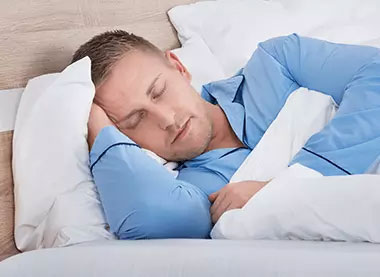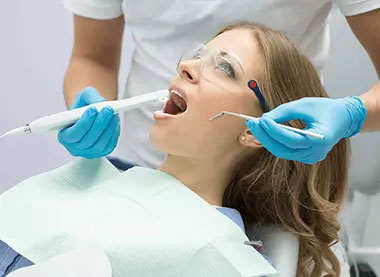What is Sleep Dentistry? Explanation

Remember when you were a kid and were scared to death of every visit to the dentist because you were sure that the creepy tools would be used to torture you? Well, most people never really get over that fear, and even as adults, they may experience some anxiety when going for treatment. Well, it's perfectly understandable to feel that way, but that doesn't negate the necessity of the actual appointment. So, it becomes a necessary evil. That being said, Sleep Dentistry might be the thing you need to help make your appointments go just a little bit smoother.
The treatment might be beneficial, not just for nervous patients or those with anxiety but also if your particular procedure will be long and complex. In such cases, the dentist might recommend sleep dentistry for your safety and health as it helps you relax during the dental process without being entirely unconscious. Most patients prefer sleep dentistry when undergoing a procedure. However, there are some questions before deciding if the technique is for you. Hopefully, this will provide some answers.
What is Sleep Dentistry?
Sleep dentistry is also called twilight dentistry, sedation dentistry, conscious sedation, and others. Regardless of the name, it is a technique used in dental care to help relax a patient during other dental procedures like cosmetic dentistry or implanting dental veneers. As the name(s) implies, this is usually done using a form of sedative administered through an injection, pill, or gas to keep you relaxed without being completely unconscious. The sedation level will be adjusted to suit the individual procedure. When undergoing the actual procedure, you remain conscious but won't feel any treatment pain.
There are several benefits to this, the most significant of which is that sleep dentistry completely removes any anxiety or nervousness that you might have felt before or during the procedure. Another benefit is that if the sedation had been applied, it would be as if no time had passed after the procedure. You'll recover much faster than if general anesthesia had been given.
Fun Fact:
In some cases, sleep dentistry can also refer to the practice of curing obstructive sleep apnea through the application of an oral appliance worn at night. In sleep apnea, tissues in the back of the throat collapse and block the airway, reducing the blood-oxygen level and causing discomfort while sleeping. The oral appliance administered helps pull forward the jaw, which opens the airway so the body can take in more oxygen.
When is Sleep Dentistry Recommended?
Some patients might request to be put under sedation by themselves for one reason or the other; however, there are certain situations where the dentist might recommend the use of sleep dentistry during the procedure.
Here are scenarios that might make a patient ask for the technique and others that might make the dentist suggest it.
1. High-level anxiety inpatient: A patient's anxiety over general dentistry procedures like the implantation of dental veneers, amongst others, might be a good reason to undergo sleep dentistry, as sedation helps to relax the patient and soothe worries.
2. Fear of pain: Some people avoid dental care for years because of a fear of the procedure. When the issue becomes so severe that they're forced to seek treatment, their anxiety might make them hypersensitive and resistant to treatment. In such cases, sleep dentistry could be recommended to soothe them during the procedure by numbing the pain until it's barely felt.
3. Back-to-back procedure: A patient might ask for sleep dentistry when they want to have several procedures done at once instead of coming back periodically. Sleep dentistry is ideal in this case because the sedative helps to make time pass quicker, and so, when the patient is removed from sedation, it is as if no time has gone.
Levels of Sleep Dentistry
There are three levels of sedation available depending on how deep under the dentist wants the patient to be. The higher the level of sedation, the less the patient will feel, even though they never go entirely unconscious.
The three sedation levels in sleep dentistry are:
a. Minimal sedation: as the name implies, minimal sedation is used at this level, and you are aware of your surroundings. The sedative here (usually a nitrous oxide or laughing gas) is generally used to induce a sense of comfort and calm nervous patients during the process.
b. Moderate sedation: Most forms of mild sedatives tend to be oral-based instead of the gaseous types used in minimal sedation. Oral sedation is given in the form of a pill. The patient is carefully monitored from the time of consumption as they will have little to no recollection of the dental procedure or anything during that timeframe.
c. Deep sedation: Deep sedation is not generally used except in cases where the process is highly complicated. For this, intravenous injection is usually utilized to administer the sedative, and the patient is at the edge of unconsciousness but can still be awakened easily.
What Do I Feel During and After the Process?
Almost anyone can undergo sedation dentistry because the procedure isn't as complicated or as scary as people make it out to be. It can also help solve people's hang-ups about dental care in general. Having said this, it is best to visit your dentist to determine if sleep dentistry is for you and address any concerns that you may have. As a general rule of thumb, though, women pregnant with children or individuals with a history of allergic reactions to sedatives should not receive sedation dentistry.
Though you'll always remain conscious, your level of awareness depends on what level of sedation you are in. For mild or minimal sedation, you feel very calm and at ease but are fully aware of everything going on around you. Though you will be awake for moderate sedation, it's more likely than not that you won't remember the procedure or will only remember bits of it. If deeply sedated, you're asleep and prone to being unaware of your surroundings.
After the treatment, though it might take a bit of time, you'll find that you recover far faster than if you had been put under actual anesthesia and will have none of the drowsiness that comes with it. The feeling of calm also usually lingers for a while, helping to conclude your appointment positively, no matter the anxiety you might have felt.
Conclusion
Sleep dentistry is a completely safe option and can be a welcome option for people who fear dental procedures like cosmetic dentistry and other more complicated treatments. The process, if used well, can go a long way in curing misconceptions about dental care and help individuals work more proactively to take care of their mouth hygiene.
If you have any questions about sleep dentistry in the Orem area, or want to try it out, Gentle Dental Arts caters to a wide variety of clients to provide the highest level of dental care. Feel free to schedule a consultation here. We look forward to getting to know you!










